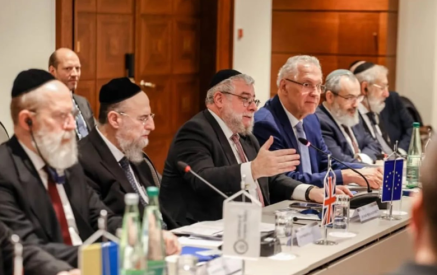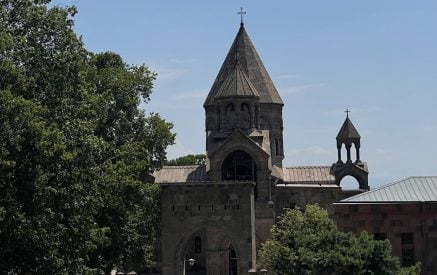The Armenian Weekly. The 85th Armenian Patriarch of Constantinople was elected on December 11, 2019 by a large margin of the votes of the delegates representing primarily civilians as well as the clergy. Bishop Sahak Mashalian has become Patriarch Sahak II. This election took place under the rules set by the government of Turkey, which has limited the candidates to bishops who are based in the region under the jurisdiction of the Patriarchate. This meant that there were only two approved candidates—Archbishop Aram Ateshian and Bishop Sahak Mashalian. It is not clear if Cologne-based Archbishop Karekin Bekciyan was not in the race due to personal choice or whether he was barred from running. Certainly, the procedures adopted by the Interior Ministry were intended to exclude a favorite candidate of many—Archbishop Sebouh Chouldjian—who is based in Armenia, but born in Turkey. If not patently, his supporters in large part led a latent campaign of no participation, protesting the elections under this format. The impact of that campaign and how much it impacted the lackluster participation levels remains controversial.
Pending a legal complaint lodged against the election rules that will be determined by the Constitutional Court, the election results are final. The new Patriarch has already received congratulatory calls from the government as well as the Catholicoses of the Armenian Church— Karekin II and Aram I. It should be noted that Sahak II as a candidate had announced that he would respect the decision of the Court if it were to annul the election and he would step down, while his opponent Abp. Ateshian did not make the same affirmative commitment.
In the recent past, specifically during the post-Ottoman, Republican era beginning in the late twenties, candidates who were born in Turkey but based abroad were allowed to run and some had become the Patriarch. These were all conditioned as “one time only,” “not to be cited as precedent”-type qualifiers by the sanctioning state authorities. The official position for the rules applied to the latest election is that these were based upon, almost identical to, the election of Patriarch provisions in the 1863 Armenian Constitution. This must be scrutinized fairly and objectively given the present-day context.
The long shadow of the Millet System
Read also
Earlier this year, the Istanbul Patriarchal election rules (yet another one-time-only special directive of the state) were announced. Much controversy ensued, but at least an election was eventually held to the relief of many Armenians living in Turkey, albeit with very limited choices. For many it was an election to pick the one who is not as bad as the other and certainly not the best qualified person to lead the fourth most important religious office in the Armenian Church, as well as the head of what remains of the nation in the western part of the homeland. While the supporters of the two candidates, and the candidates themselves, at times went over and beyond the traditional boundaries on politicking and personal attacks, almost 40 percent of the election organizing committee comprised of respected leaders of the community resigned. This was primarily due to intense political interference by the authorities and the limitations imposed on what should be a free exercise of religious rights to elect one’s own leader. The election under the rules proceeded and appears to have been fairly administered. No one contested the result of the vote.
The main criticism pertained to limiting the election to the two bishops. It is true that the current rules of eligibility are not much different from those prescribed under the 1863 Armenian Constitution: minimum age 35 years old; being an Ottoman citizen (now, Turkish citizenship) from the paternal side and belonging to the class of Bishops traditionally belonging to and part of the Patriarchate. Of course, this ignores the fact that there is a vast difference between the pool of candidates, bishops from over 2,000 church parishes, hundreds of diocesan districts pre-1915 and the current numbers, which by this most recent rule were reduced to “two” eligible bishops. It further ignores the fact that the current election is primarily for that of a religious leadership and not including the dual capacity as the head of the nation, the millet. The 1863 Constitution vested awesome powers in the hands of the elected Patriarch. As spelled out clearly in Article IV, Section 1, the Patriarch of Constantinople had full executive powers to preside over and lead the Civilian Parliament and Religious Council of the Armenian Nation in the empire and also as the individual arm of the State charged with enforcement and execution of the laws of the Ottoman Empire. Section 3 of the same article provided that the final appointment as Patriarch would occur by the approval and consent of the Sultan.
Now all of a sudden there has been a reversion to the literal words of 1863. Of course, this ignores the giant elephant in the room: the missing dioceses who were represented in 1863, from Van to Egypt and Jerusalem, from Diyarbakir and Adana, to Adrianople/Edirne or Varna in Bulgaria. In the new delegate/representative list there are only five “provincial” representatives of very small parishes such as Kayseri, Iskenderun, Diyarbakir, and the last Armenian village left in Turkey, Vakif in Musa Dagh.
The recent landmark decision by the Constitutional Court of Turkey called for respect for the religious traditions and recognized their individual rights to free exercise of faith by the minority Armenians. It based its decision not only on the 1863 Constitution, but also the Lausanne Treaty and other civil rights jurisprudence in a lengthy landmark opinion.
Allowing a free choice
While there is no question that the Patriarchate founded by Mehmed II in 1461 exists within the framework of the State, given the stark reality of the difficulty to find qualified candidates from a drastically limited pool of bishops, all who meet the basic requirements should have been allowed to enter the race. It is unclear whether most Armenian bishops would even consider running, because the office calls for making remarks and statements that no proud son of the Armenian nation would like to make, such as being forced to engage in genocide denial. Further, to be considered a “good Armenian,” the Patriarch must utter government talking points about the evil Diaspora and Artsakh. Still all should have been allowed to run, and members of the Armenian community in Turkey should have been allowed to make their free choice.
There is no reason to be apprehensive about allowing the remaining 60,000 Armenians in their native land to decide who they want to be their religious leader. Let them choose any bishop who was born in Turkey, is a citizen or is born to an Armenian (father or mother) who was born in Turkey and was a citizen. This is consistent with precedent. When after a long crisis between 1944 and 1950 and bitter rivalries by the local archbishops Aslanyan (locum tenens who usurped power post the second forced exile of Genocide-era Patriarch Zaven Der Yeghiayan) and his archrival Bahtiyaryan, the Armenians of Turkey elected Archbishop Karekin Khatchatourian, the Primate of the Diocese in Buenos Aires, Argentina, as their new Patriarch! Despite Aslanyan’s objections on the citizenship and church connection grounds, the government approved the election. The free choice of Armenians was also respected when his successor and long-term beloved Patriarch Shnork Kalustian was elected in 1963, despite having served all over the world (including as Primate of the Western Diocese of the United States). Patriarch Kalustian was able to maintain the dignity of the Armenian nation without offending the Turkish government.
To conclude, the maxim of “let the people choose” would have been a much-preferred option. We still had two bishops based in Istanbul and several abroad who met the tradition and precedent. Such a process would have made it easier to accept the results. Nevertheless, we were able to elect a Patriarch around whom this small, battered, divided community will and must unite. Maintaining a cultural presence, over 30 churches, many schools, orphanages and hospitals is a gargantuan task this devoted community in Istanbul has managed to accomplish. And I am sure that the community will make a wise choice should the Constitutional Court pave the way for a new election. Regardless, those of us in the Diaspora and in Armenia should criticize and raise objections to unacceptable acts and statements by the Patriarch, albeit with some understanding of the difficult circumstances in which our ancient institution operates in today’s Republic of Turkey.
Edvin Minassian
Photo: Istanbul Patriarch Sahak II



























































